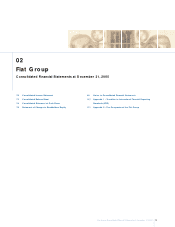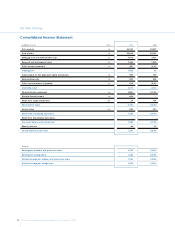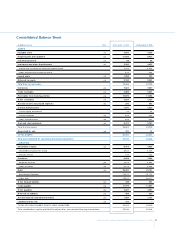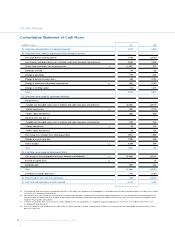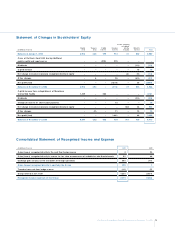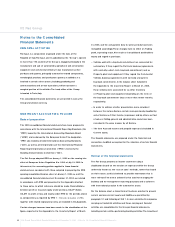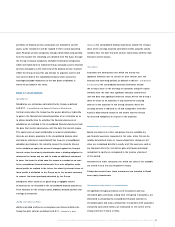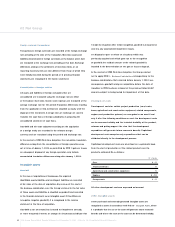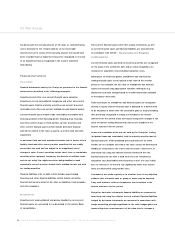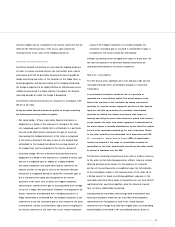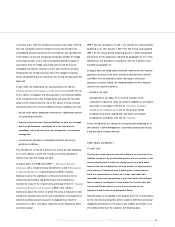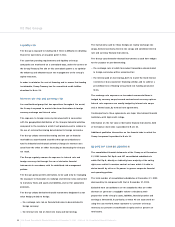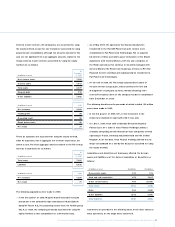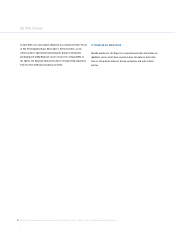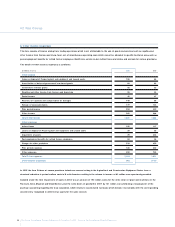Chrysler 2005 Annual Report Download - page 86
Download and view the complete annual report
Please find page 86 of the 2005 Chrysler annual report below. You can navigate through the pages in the report by either clicking on the pages listed below, or by using the keyword search tool below to find specific information within the annual report.
85
Fiat Group Consolidated Financial Statements at December 31, 2005 - N otes to the Consolidated Financial Statements
relevant hedged risk, are recognised in the income statement and are
offset by the effective portion of the loss or gain arising from
remeasurement at fair value of the hedging instrument.
Derivative financial instruments
Derivative financial instruments are only used for hedging purposes,
in order to reduce currency, interest rate and market price risks. In
accordance with IAS 39, derivative financial instruments qualify for
hedge accounting only when at the inception of the hedge there is
formal designation and documentation of the hedging relationship,
the hedge is expected to be highly effective, its effectiveness can be
reliably measured and it is highly effective throughout the financial
reporting periods for which the hedge is designated.
All derivative financial instruments are measured in accordance with
IAS 39 at fair value.
W hen derivative financial instruments qualify for hedge accounting,
the following accounting treatment applies:
Fair value hedge - W here a derivative financial instrument is
designated as a hedge of the exposure to changes in fair value
of a recognised asset or liability that is attributable to a particular
risk and could affect income statement, the gain or loss from
remeasuring the hedging instrument at fair value is recognised
in the income statement.The gain or loss on the hedged item
attributable to the hedged risk adjusts the carrying amount of
the hedged item and is recognised in the income statement.
Cash flow hedge - W here a derivative financial instrument is
designated as a hedge of the exposure to variability in future cash
flows of a recognised asset or liability or a highly probable
forecasted transaction and could affect income statement, the
effective portion of any gain or loss on the derivative financial
instrument is recognised directly in equity.The cumulative gain or
loss is removed from equity and recognised in the income
statement at the same time at which the hedged transaction
affects income statement.The gain or loss associated with a hedge
or part of a hedge that has become ineffective is recognised in the
income statement immediately.W hen a hedging instrument or
hedge relationship is terminated but the hedged transaction is still
expected to occur, the cumulative gain or loss realised to the point
of termination remains in stockholders’ equity and is recognized in
the income statement at the same time as the related transaction
occurs. If the hedged transaction is no longer probable, the
cumulative unrealised gain or loss held in stockholders’ equity is
recognised in the income statement immediately.
If hedge accounting cannot be applied, the gains or losses from the
fair value measurement of derivative financial instruments are
recognised immediately in the income statement.
Sales of receivables
The Fiat Group sells a significant part of its financial, trade and tax
receivables through either securitisation programs or factoring
transactions.
A securitisation transaction entails the sale of a portfolio of
receivables to a securitisation vehicle.This special purpose entity
finances the purchase of the receivables by issuing asset-backed
securities (i.e. securities whose repayment and interest flow depend
upon the cash flow generated by the portfolio).Asset-backed
securities are divided into classes according to their degree of
seniority and rating: the most senior classes are placed with investors
on the market; the junior class, whose repayment is subordinated to
the senior classes, is normally subscribed for by the seller.The residual
interest in the receivables retained by the seller is therefore limited
to the junior securities it has subscribed for. In accordance with SIC-
12 - Consolidation - Special Purpose Entities (SPE), all securitisation
vehicles are included in the scope of consolidation, because the
subscription of the junior asset-backed securities by the seller entails
its control in substance over the SPE.
Furthermore, factoring transactions may be with or without recourse
to the seller; certain factoring agreements without recourse include
deferred purchase price clauses (i.e. the payment of a minority
portion of the purchase price is conditional upon the full collection
of the receivables), require a first loss guarantee of the seller up to
a limited amount or imply a continuing significant exposure to the
receivables cash flow.These kinds of transactions do not meet IAS 39
requirements for asset derecognition, since the risks and rewards
have not been substantially transferred.
Consequently, all receivables sold through both securitisation and
factoring transactions which do not meet IAS 39 derecognition
requirements are recognised as such in the Group financial
statements even though they have been legally sold; a corresponding
financial liability is recorded in the consolidated balance sheet as


